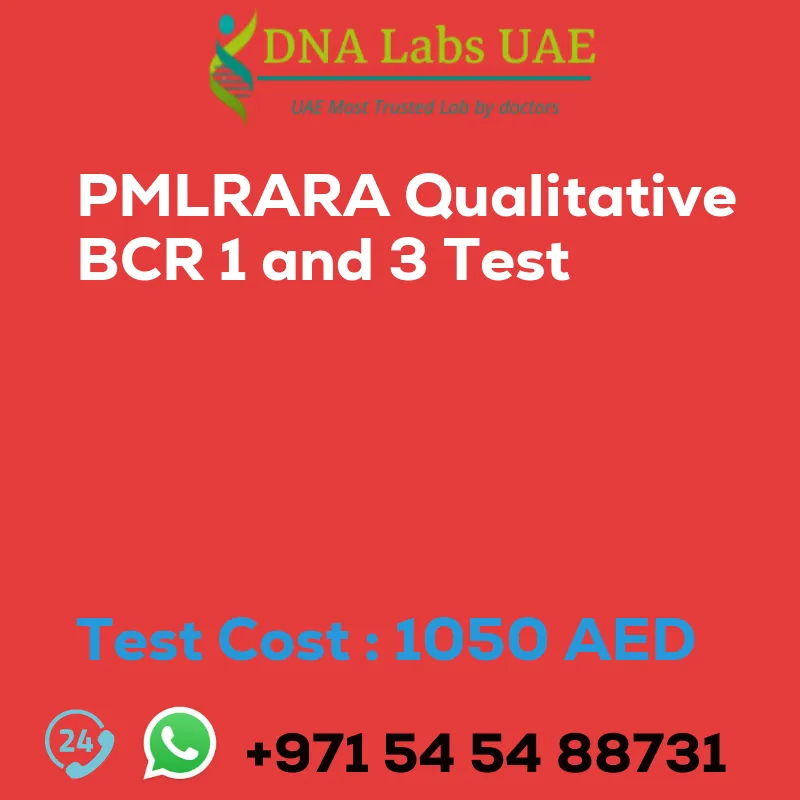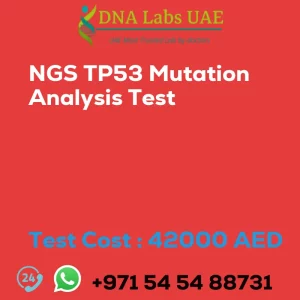PMLRARA Qualitative bcr 1 and 3 Test – Cost, Symptoms, Diagnosis
Test Name: PMLRARA Qualitative bcr 1 and 3 Test
Components: EDTA Vacutainer (4ml)
Price: 1050.0 AED
Sample Condition: Bone marrow / Peripheral blood (Transport immediately)
Report Delivery: 2-3 days
Method: Real Time PCR
Test Type: Genetics
Doctor: General Physician
Test Department:
Pre Test Information
PML/RARA Qualitative bcr 1 & 3 Test can be done with a Doctor’s prescription. Prescription is not applicable for surgery and pregnancy cases or people planning to travel abroad.
Test Details
PML/RARA is a specific genetic mutation that occurs in acute promyelocytic leukemia (APL), a subtype of acute myeloid leukemia (AML). The mutation involves the fusion of the promyelocytic leukemia (PML) gene on chromosome 15 with the retinoic acid receptor alpha (RARA) gene on chromosome 17.
Qualitatively, the PML/RARA fusion gene has several important implications for APL. Firstly, it disrupts the normal function of both the PML and RARA genes. The PML gene is involved in regulating cell growth and division, while the RARA gene plays a role in the differentiation of immature cells into mature cells. The fusion of these genes leads to abnormal cell proliferation and impaired cell differentiation, contributing to the development of APL.
Furthermore, the PML/RARA fusion gene is associated with sensitivity to a specific treatment approach called targeted therapy. All-trans retinoic acid (ATRA), a derivative of vitamin A, is the mainstay of treatment for APL. ATRA binds to the RARA portion of the fusion protein, causing differentiation of the leukemia cells and inducing remission. This targeted therapy has significantly improved the prognosis for patients with PML/RARA-positive APL, leading to high rates of complete remission and long-term survival.
In addition, the PML/RARA fusion gene has diagnostic significance. Its detection through molecular genetic testing, such as fluorescence in situ hybridization (FISH) or polymerase chain reaction (PCR), is crucial for confirming the diagnosis of APL. The presence of the fusion gene is a hallmark of APL and differentiates it from other subtypes of AML.
Overall, the qualitative aspects of PML/RARA in APL highlight its role in disease pathogenesis, its sensitivity to targeted therapy, and its diagnostic significance. Understanding the molecular characteristics of PML/RARA has revolutionized the management and prognosis of APL, making it a distinct entity within the spectrum of AML.
| Test Name | PMLRARA Qualitative bcr 1 and 3 Test |
|---|---|
| Components | EDTA Vacutainer (4ml) |
| Price | 1050.0 AED |
| Sample Condition | Bone marrow \/ Peripheral blood (Transport immediately) |
| Report Delivery | 2-3 days |
| Method | Real Time PCR |
| Test type | Genetics |
| Doctor | General Physician |
| Test Department: | |
| Pre Test Information | PML/RARA Qualitative bcr 1 & 3] can be done with a Doctors prescription. Prescription is not applicable for surgery and pregnancy cases or people planing to travel abroad. |
| Test Details |
PML/RARA is a specific genetic mutation that occurs in acute promyelocytic leukemia (APL), a subtype of acute myeloid leukemia (AML). The mutation involves the fusion of the promyelocytic leukemia (PML) gene on chromosome 15 with the retinoic acid receptor alpha (RARA) gene on chromosome 17. Qualitatively, the PML/RARA fusion gene has several important implications for APL. Firstly, it disrupts the normal function of both the PML and RARA genes. The PML gene is involved in regulating cell growth and division, while the RARA gene plays a role in the differentiation of immature cells into mature cells. The fusion of these genes leads to abnormal cell proliferation and impaired cell differentiation, contributing to the development of APL. Furthermore, the PML/RARA fusion gene is associated with sensitivity to a specific treatment approach called targeted therapy. All-trans retinoic acid (ATRA), a derivative of vitamin A, is the mainstay of treatment for APL. ATRA binds to the RARA portion of the fusion protein, causing differentiation of the leukemia cells and inducing remission. This targeted therapy has significantly improved the prognosis for patients with PML/RARA-positive APL, leading to high rates of complete remission and long-term survival. In addition, the PML/RARA fusion gene has diagnostic significance. Its detection through molecular genetic testing, such as fluorescence in situ hybridization (FISH) or polymerase chain reaction (PCR), is crucial for confirming the diagnosis of APL. The presence of the fusion gene is a hallmark of APL and differentiates it from other subtypes of AML. Overall, the qualitative aspects of PML/RARA in APL highlight its role in disease pathogenesis, its sensitivity to targeted therapy, and its diagnostic significance. Understanding the molecular characteristics of PML/RARA has revolutionized the management and prognosis of APL, making it a distinct entity within the spectrum of AML. |







